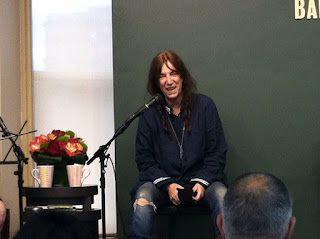I came across this in June as part of the Hyperallergic newsletter that lands in my inbox twice a week.
“Oh,” I thought, “that’s kind of pretty and creative – I bet the kids om Tumblr would like it.” It has just enough unusual-ness, mixed with just enough eye-catching design, and a certain crafty appeal that made me think it’d be perfect.
Um, yes?
I do stop and wonder if anyone who’s liked or reblogged this from me has actually tried this; more than that, I’m curious how much traffic Sugar Nails (the originator of the photo) has seen from it. But mostly, I’m amazed – just flat-out amazed – at how much Tumblr-ers like and share this around. One thousand-plus notes?! Wow.
My big regret is that I didn’t pull a meta-moment and take a photo of this to stick on Instagram – because the popular photo-sharing service has now surpassed Twitter for users. How many more “likes”? How many more “notes”? How many more shares? Following the numbers can be a breathless business, and more than a little addictive. It’s nice to be popular, even (or especially) when you don’t have to reveal a thing about yourself in the process. No one knows whether or not I paint my nails, or indeed, I may’ve tried the nail art above (confession: I haven’t). But the more I work in digital journalism, the more I’m determined to keep my private life private; I curate what I share from my real life the way I do with links, news, @s, photos, and status updates. But what to do when something awfully personal goes viral? How would I feel if an awfully personal aspect of my life had 1,313 notes?
Online culture is, in many ways, a numbers game: how many followers, how many “likes”, how much, and how fast. It’s less about originality (hey, these aren’t my nails after all, much less my photo) and more about who’s first and who gets noticed when. That can ratchet up personal drama online, resulting in a sometime-CAPS-lock style proselytizing. Some are able to channel drama into a meaningful expression and assessment of their experiences (see: my friend Diana Rodriguez’ smart blog). Some are able to build a solid brand through their particular sort of online sharing. And yes, I could gain tons more followers by publicizing various aspects of my life, but the price feels too high.
And so, I find photos of things I find curious, interesting, share-worthy, and I post them, and people share. Sometimes they share my professional (/original) work -which is even better. Every time that happens, I’m reminded of my gratitude toward my followers across various online platforms -my Facebook subscribers, my Instagram, Pinterest, and Twitter followers, my blog and Digital Journal readers: I’m grateful for all of them -you, that is -and always will be, nails or no nails. Now here’s a neat online thing – please like and share it!


